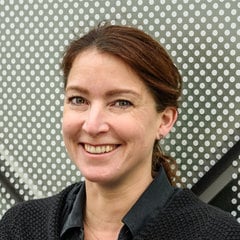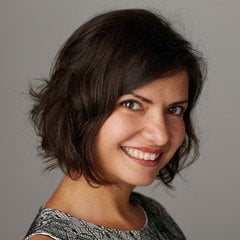Discover legacy content from FontShop.com, preserved for your reference.
One would think that type design – being an artistic profession with less pronounced hierarchical structures – would be less prone to gender inequality. In a recent e-mail exchange MA Typeface Design Course Director Gerry Leonidas revealed that the share of women graduating from the post-graduate course at the University of Reading is steadily increasing. Even better – when you track the distribution in blocks of five years to eliminate annual random variations it grew from 62.5% men, 37.5% women for the graduation 2000–2004 to a perfect 50/50 for the graduation 2009–2014. This supports Gerry’s position that early years confirm the older male bias in the industry, whereas the trend clearly shows that entry into the profession is gender neutral.

Gerry Leonidas | “I note that these numbers are not indicative of career progression! It is much more difficult to collect reliable data for the question ‘what is the gender balance for people whose main income relies on designing and making typefaces’ or even ‘what is the gender balance for people whose main income relates to typeface design’?”
Indeed, even if their number is growing in the major type design courses, women are still a minority in the profession. FontFont for example selects new type submissions solely on the basis of typographic quality – I should know, I have attended every TypeBoard meeting for the past few years – yet has 8 male type designers for every female designer. Women are also generally less visible – at the ATypI conference in Barcelona last Fall the male speakers outnumbered the female speakers by a factor 4 to 1, while women were conspicuously absent on the Robothon 2015 stage two weeks ago. Since its inception in 1982, Alexandra Korolkova was only the second woman to win ATypI’s prestigious Prix Charles Peignot last year, after Carol Twombly in 1994. Even though the two last winners of the SOTA Typography Award were both women – digital type design legend Zuzana Licko in 2013 (two decades too late) and foreign script specialist and lecturer Fiona Ross in 2014 (also overdue) – the list preceding them consists exclusively of men. And no woman has won the Gerrit Noordzij Prize yet.

Verena Gerlach firmly believes no professional activity is more appropriate for one gender than for the other. She argues that the factors holding back women from achieving equal success in type design are not necessarily inherent to the profession itself, but rather caused by the traditional gender roles in society.
Verena Gerlach | “It has nothing to do with creativity or aptitude. The only factor specifically related to typeface design might be the actual time needed to create a typeface, as it is a lengthy and intense process. Women are still expected to devote their spare time to their household and family, not to drawing alphabets and developing fonts. Then there’s the fact that society at large somehow decided that certain activities match one gender better than the other, and disapproves if someone of the ‘wrong’ gender chooses an ’inappropriate” profession. It’s as if people blindly accept someone decreed these rules, and unfortunately they follow them.”
“Because mostly men work in this field due to these two factors, it can be hard for women trying to break through to deal with this primarily male group. Plus there is a lot of competition. If a female type designer can’t deal with this incessant rivalry anymore, society will accept, even applaud her if she decides to return to family life. A man however would lose his male credibility if he took refuge into becoming a full-time dad, so men need to be extremely competitive; it is their only option. I am still convinced that a tendency towards either family life or job competition is not defined by our chromosomes, but are the product of hundreds of years of strange traditions and rules that are supposed to make you feel comfortable in your predefined place in society. It’s convenient to lay the blame on one’s gender.”

Nadine Chahine does not share Verena’s opinion that the time-consuming aspect of typeface design makes it more difficult for women to practice it, even though she agrees that choosing to start a family can compromise women’s options.
Nadine Chahine | “The nature of type design is one that allows a lot of flexibility in work schedules and does not require too many client meetings. If it is a choice for working mothers, it’s actually quite a good option. However, I have noticed I have had to work twice as hard to prove that whatever progress I achieved in my career is due to the quality of my work, not to any physical attributes I might be lucky to have. This has come up a few times, but if you work hard the results will speak for themselves. And after a certain point it becomes easier once you’ve proven what you are able to do. I have yet to meet a client who objected to my gender.”
“It is difficult to make broad assessments, but I do know that if I had chosen to have a family I would not be able to work the hours I do now, or travel as much as I do. This is the reality that many women in many professions have to face – the responsibility of child rearing often has the strongest impact on the mother, not the father, and that has the biggest implications when the children are still young. I suppose this becomes less crucial once children grow up but that time away from work can substantially set back the progression of your career.”

Emanuela Conidi is persuaded that typefaces are not judged based on the gender of the designer, but rather on their quality. She likes to think there is meritocracy in type design.
Emanuela Conidi | “As someone who has read – and still does – some typography-related history, I can safely say there are more women in type design today than ever before. Gender is much more a reality in other careers than in our professional field. Is the ‘technical’ aspect of type design, though influential, the actual reason for the lower number of women? Or should we expect more women – gifted with a higher degree of delicacy, care or patience – to be involved because of the ‘crafting’ aspect? I think it is a matter of choices, and women simply have some catching up to do in fields historically dominated by men (and vice versa). The question is if women who want to enter those careers don’t get the opportunity, rather than if they have no interest in the first place. I am not sure if bosses have gender stereotypes on their mind when looking for new employees. I would be more concerned with hiring talent, rather than be focused on gender. For the same reason I wouldn’t employ more women in my company just to make a point, only if they were better at their job than their male counterparts.”
“Anyone can learn and use the tools. We all have to work hard and carve out a place for ourselves in a highly competitive environment. And although talent and luck always help in every aspect of life, personality, motivation, passion, persistence, patience and commitment will help achieve your goals as a person, not as woman. There is another aspect to consider. Excuses can be safety nets to justify not accomplishing things due to other reasons we don’t like to admit, and a great way to cover up for things that we don’t really want to do, as men or as women.”
“Finally I think the constant comparison women/men is not very productive nor healthy. Why do we have to try to be better than men instead of in our own rights? Why can’t everyone simply concentrate on improving themselves as people in whatever they do and be done with it?”
Being the first and only female type designer at fontsmith, Emanuela doesn’t believe the gender discrepancy at the London-based independent type design studio was intentional.
Emanuela Conidi | “Fontsmith hired me one month after finishing my MATD course, and I wasn’t the only woman interviewed. It was clear from the beginning that me getting the job was more a matter of personalities ‘clicking’ together than anything else, in particular because the team could be counted on one hand – everybody sits around the same table eight hours a day. I never experienced any difficulty or discrimination. Neither did I ever feel held back nor was my opinion taken less seriously because I was the only female designer. And quite frankly I wouldn’t have expected it either. Again, this is my personal experience and if I may say so… a very happy and positive one.”
At Petr van Blokland’s house party at the Robothon conference Nina Stössinger made a remark about the absence of women on the roster of speakers at Robothon.
Nina Stössinger | “To be honest I think the technical corner of type design – type technology, tool development – currently has barely any women in it. On the one hand I was sad about the lack of female speakers, yet on the other hand I couldn’t really come up with women that might have been invited. I’m a bit in two minds about this. Personally I’d rather be recognised for my work than for my chromosomes (as I’m sure many women in the field). I would not want any special treatment because of my gender. However, it could be quite valuable to set examples by helping make female designers/coders more visible and making the profession not just look like a “guys’ thing”, specifically for young women just starting out.”
“I suspect that part of it is that there simply are fewer women who are interested in code and the more technical aspects of type design, and that would be just fine. I don’t believe that every field, on principle, ideally needs total gender parity. But we do need to make sure there are no systemic obstacles holding women back, and that there is encouragement. We have to support women learning how to code; we have to hold up the flag that geek girls are cool. In his message to the conference, Python creator Guido van Rossum wore a t-shirt in support of women who code. He rocks.”
“Typeface design certainly has more men in the profession, lots of white men in particular. But I do not think there is a prejudice against women at all – it feels like a fairly open and welcoming scene, especially for newcomers. I am under the impression that compared to other fields (cough games cough) the type scene is actually very supportive of women.”



